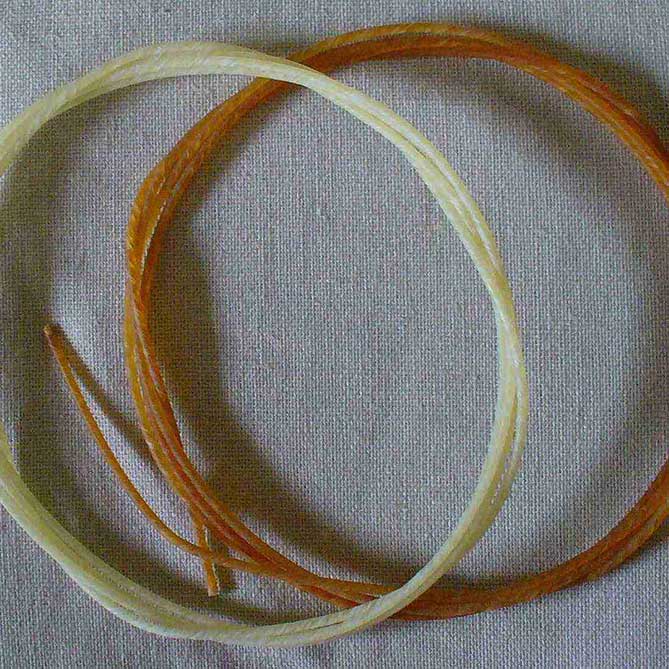
On How to Play a Baroque Cello: Gut Strings (Part 2)
Guy Fishman
In last week’s blog, I outlined a brief history of gut strings in the 20th century. Here I complete my blog on gut strings, and also offer a bit of advice on their use.
There is no doubt that the character of the sound of gut strings differs from that of steel. Gut has what is usually described as a warm sound. This is despite the fact that the surface tension of gut is much higher than steel, and the “buzz” that musicians often hear under their ears coming from gut strings is part of what propels the sound toward the listener. I have found that the variety of color between the strings and along the same string, especially on unwound gut, creates a great deal of interest in the ear and dissipates the need for higher decibel levels. I question if these are significantly higher with steel strings, on which players use a variety of technical tools in order to create the impression of greater volume, as well. Clearly, I have an opinion about gut, steel, and volume, and I just can’t get behind the claim that gut strings’ volume, or, rather, their perceived volume, should be a reason for relegating their use to performance on period instruments only.
To be sure, there are traits in gut strings that may seem foreign to those of us who have grown up with steel strings. For instance, you will need to bid your fine tuners a fond fare-thee-well. For players using a tailpiece with stationary adjusters, this will mean having to get a classic wooden tailpiece with holes for where adjusters, or in this case the strings, will go. You will have to learn to loop the ends of your strings, though string makers provide easy-to-follow instructions. Gut strings fray, in good weather and bad. Far from signaling the end of a string’s usefulness, this merely has to be attended to with nail clippers. You will have to choose varnished or unvarnished strings, both of which will take getting used to, especially where shifting and sliding are concerned (cleaning gut strings is even more vital than with steel strings, for this reason).
There are other differences. Where steel strings generally come in three gauges—soft, medium, and forte—gut strings may be sanded to myriad diameters. Some luthiers can calculate a basic gauge based on an instrument’s dimensions, and string makers will be happy to make a recommendation, but experimentation is really the only way to determine what works for your instrument. If I may, I recommend as thick a string as you can manage, which will constitute another significant difference from steel. For instance, the string maker I like for my top two strings has a table on his website that lists the gauges 1.28mm and 1.60mm for the A and D strings, respectively, as being “Heavy+.” The gauges I use are 1.34mm and 1.68mm, though if the D string sounds too cumbersome, consider that the great 19th century German cellist Bernhard Romberg used a D string that was 2.00mm thick! Lower strings, too, come in different gauges, though the choices are fewer. Pirastro offers several brands, and the tungsten-wound G and C strings in their “Passione” line are quite thin. Players who emphasize the historical correctness of their strings will take issue with tungsten being used (or with every Pirastro string, for that matter), but may yet delight in how long these strings last before starting to fray at the bridge.
By far, the biggest difference for me was relearning the role of the sounding point. Subsequently, this is the tool I use most often to create what shading I’m able to in my own playing on gut strings. Of course, seeking a sounding point to create the desired tone is of paramount importance on strings of any composition. But I find that on gut strings even the minutest changes to the point at which the bow grabs the string make an immense difference. You may find that, in general, notes that require emphasis be placed somewhat closer to the bridge, with less bow speed. For instance, in the opening to the prelude of the 4th suite for unaccompanied cello by Bach, each of the first four eighth-notes may potentially be played at a different point on the string, depending on the player’s opinion of its importance in the hierarchy of the measure. I will go so far as to suggest that in a chord or double stop, the note you wish to have sounding more should be played closer to the bridge, while the less important one is played farther away, simultaneously. The technique works, even if one has to momentarily suspend one’s attempt at a bow stroke that is parallel to the bridge, which is widely accepted as a cornerstone of good technique. These suggestions may be applied to steel strings, but on gut (which I use on both baroque and standard cellos) they come into relief as indispensable.
In an interview with Tim Janoff for www.cello.org, Steven Isserlis says: “I use gut strings because I like them, and because they are an essential part of my musical voice.” (In the same article, he responds to accusations that he cannot be heard in concerti due to his use of gut strings). Ultimately, a player should choose strings that help him or her produce the sound conjured in the mind’s ear. But too many players have been turned away from almost 400 years of tradition due to what I believe is essentially an advertisement campaign for steel strings. You may end up returning to Jargar and Larsen as the realization of your sonic dreams. Still, I hope that this article can serve as encouragement for you to try the sort of strings with which so many of our illustrious forebears produced their magnificent tone, and sample them unencumbered by misconceptions that do not intrinsically amount to much more than a sales pitch.
Appendix:
Further information on the history and making of gut strings may be found here and here. A comprehensive article on the history of strings in general may be found here. Dr. Thomastik provides a picture of the beginnings of the steel string industry for the violin family here.
I have attempted to maintain CelloBello’s non-commercial and non-promotional stance and have not listed my preferred string makers by name. If you are interested in my opinions, experiences, and suggestions, feel free to contact me.
Subjects: Baroque, Historical
Tags: Baroque, cello, cellobello, gut strings, Guy Fishman, Tim Janoff
